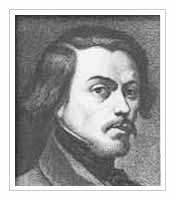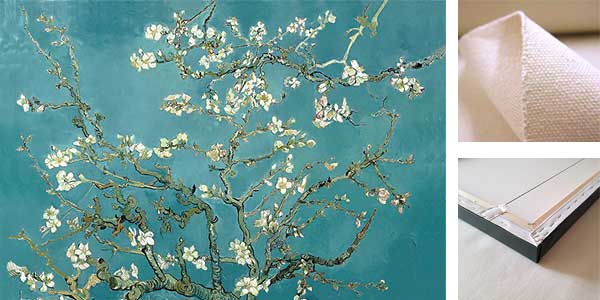
Eugène Delacroix (1798 – 1863)
French Romantic Painter Eugène Delacroix was born on 26 April 1798 at Charenton-Saint-Maurice in Île-de-France, near Paris. Delacroix’s mother, Victoria, came from a family of famous cabinetmakers, Oeben and Riesener. Her husband, Charles Delacroix, had held various important governmental posts under the Republic, the Directory and the First Empire. It is now generally accepted, however, that Eugene Delacroix’s natural father was that supreme diplomat and éminence grise, Charles-Maurice de Talleyrand.
After the death of Charles and then of Victoria Delacroix, Eugene, impoverished, went to live with his sister, Madame de Verninac, whose husband had been an ambassador to Turkey. Trained, like Théodore Géricault, in the atelier of Pierre-Narcisse Guérin at the Paris School of Fine Arts, Delacroix was soon fully committed to the painting of grandes machines. Although a non-conformist, he was anxious to obtain government commissions and felt no compunction about working on those allegories and religious themes that were the staple of State patronage at the time.
The Bourbon restoration
During the Bourbon restoration, Delacroix became interested in exotic subjects which he learned about through travel books, literature and accounts of topical events in the Near East, notably the Greeks’ fight for independence. With his firm friend Richard Parkes Bonington (who taught him about the very English art of watercolour), he shared a passion for Lord Byron’s writings ; the poems of the eccentric and flamboyant Englishman, who died in 1824 during the defense of Missolonghi, were set in Greece and Turkey. Delacroix also talked with travellers, such as Jules-Robert Auguste, known as Monsieur Auguste. This wealthy painter and collector of Oriental art and curiosities had made his Paris house a centre for artists and writers newly interested in the Near East, as well as for Greek political refugees.
It was Monsieur Auguste who lent Delacroix Oriental clothes and objects for his picture Le Massacre de Scio (Massacre at Chios) (Musée du Louvre, Paris), which caused consternation at the 1824 Salon. Described by Baudelaire as a terrifying hymn in honour of doom and irremediable suffering, it drew Delacroix willy-nilly into the Romantic movement, of which he became the reluctant but undisputed leader. At the 1827 Salon, he showed La Mort de Sardanaple (Death of Sardanapalus) (Musée du Louvre, Paris), inspired by Byron’s play. This violent and discordant picture, of an Assyrian potentate reclining impassively amidst writhing bodies, produced an uproar.
Orientalist paintings
Other, less excessive Orientalist paintings followed, such as Turc au Harnais (Turk with Harness) (Musée du Louvre, Paris), Mameluck å Cheval (Mameluke on Horseback) and Combat du Giaour et du Pacha (Combat of the Giaour and the Pasha) (The Art Institute, Potter Palmer collection, Chicago), depicting a furious fight between horsemen, again inspired by Byron. Delacroix later painted another version, in 1835 (Musée du Petit Palais, Paris) (illustrated opposite). Thoroughbred horses — and felines were his favourite animals and appeared consistently in his work. Already in 1817, he and Géricault had sketched together at the Paris Zoo. Delacroix’s paintings of animals were never naturalistic; they were excuses for displaying beauty of movement, unfettered ferocity and power.
Through his contacts in official circles, Delacroix was invited to travel with the entourage of the comte de Mornay, special envoy to the Sultan of Morocco, Moulay AbderRahman. The mission left Toulon for Tangiers, where it disembarked on the 25th January 1832. Delacroix was immediately struck by the dignified dress and bearing of the Moroccan people of all walks of life. They were, he felt, living figures from classical history. He noted: “Rome is no longer in Rome, the ancient world had nothing lovelier.” The sizzling colours and bright light deeply impressed him, too, and were to enhance his already masterly use of brilliant paint surfaces and vibrant harmonies of broken colour.
Eugène Delacroix in Morocco
Throughout his stay in Morocco, he made day-to-day pencil and watercolour sketches, annotated with a running text. These were contained in seven small notebooks, sold in his studio sale. One is now in the Musée Condé in Chantilly and two are in the Cabinet des Dessins (Musée du Louvre, Paris). A fourth notebook, auctioned by Sotheby Parke Bernet Monaco in Monte Carlo in June 1983, was pre-empted by the Louvre. These rapid, fluid sketches were to provide him with an inexhaustible supply of material for the following thirty years. It was extremely diffcult for artists at this time to draw Muslims, although Jacques Delaporte, the French vice-consul, invited some notables to the consulate to meet Delacroix. It was relatively easy, however, to persuade the Jewish population to pose.
Amongst the many portraits Delacroix made was a charming one of the daughter of Abraham ben Chimol, a Jewish dragoman to the mission. One of the eighteen watercolours given by the artist to the comte de Mornay, it was auctioned in 1877 on the count’s death. The mission set off for Meknös in March, accompanied by one hundred and twenty horsemen, thirty bearers and forty-two mules. Delacroix was able to sketch the sultan who, after the satisfactory conclusion to the negotiations, presented a lion, a tiger, an ostrich, two gazelles and four horses for King LouisPhilippe. It was difficult to work in Meknös without interference, however; Delacroix was always followed by a threatening band of people. Even to step out on the terrace exposed him to stones and gunshots.
excursion to Spain
After a short excursion to Spain while waiting for the official signature to the treaty, the mission finally left Tangiers in June and, after putting in at Oran, disembarked in Algiers on the 25th. During this three-day stay, Delacroix seems to have been able to arrange a visit to the harem of the dey’s reis. From this, came one of the most famous of all Orientalist paintings, Femmes d’Alger dans leur appartement (Women of Algiers in their Quarters) (Musée du Louvre, Paris) (illustrated below), in which the lounging and languorous women exude an eroticism in an atmosphere of deep tedium.
Although Delacroix continued his offcially commissioned decorations, alternated with pictures inspired by Byron, Dante and Shakespeare, he remained haunted by his African journey. Using his sketches and notes, he painted the scenes he had witnessed: religious fanatics, fantasias, a Moroccan caid visiting a tribe, Jewish musicians from Mogador, the Sultan of Morocco surrounded by his guard.
Often existing in more than one version, they are now mostly in European and North American museums. During the 1850s, Delacroix’s Orientalist pictures became less and less realistic as his impressions faded. Painted with a Rubenesque exuberance, often of odalisques or of fierce combats, péle-méles of lions, horses and men, they conjured up an imaginary, exotic and sumptuous Orient.
After Delacroix’s death
After Delacroix’s death (he had suffered from chronic laryngitis since 1842), his friends were entrusted with making an inventory of his studio. Pierre Andrieu (Delacroix’s close collaborator and alter ego) catalogued the studies and unfinished paintings, while the critic Philippe Burty classified the some six thousand drawings. Many of the latter are now in the Cabinet des Dessins (Musée du Louvre, Paris). In 1929, the painter Maurice Denis founded the Société des Amis d’Eugéne Delacroix, which rented the artist’s flat and studio in rue de Furstenberg in Paris. Exhibitions of his work were held there from 1932. The premises were eventually bought by the State to create the national museum that it is today.
Literature: A. Robaut and E. Chesneau, L’Œuvre complet de Eugène Delacroix, Paris, 1885; M. Serullaz, Delacroix, aquarelles du Maroc, Paris, 1951; L. Johnson, Eugène Delacroix, Toronto, 1962; E. Escholier,Eugène Delacroix, Paris, 1963; M. Serrulaz, Delacroix, Paris, 1981; L. Johnson, The Paintings of Eugène Delacroix, a critical catalogue 1816-1831, Oxford, 1981, 2 vol.
Exhibitions: Eugène Delacroix, Ecole Nationale des Beaux-Arts, Paris, 1885; Eugène Delacroix, Musée du Louvre, Paris, 1930; Centenaire d’Eugène Delacroix, Musée du Louvre, Paris, 1963.
Studio sales: 17-19 February 1864 (pictures), 22-27 February 1864 (drawings), 29 February 1864 (eaux-fortes, lithographs), Drouot, Paris.
